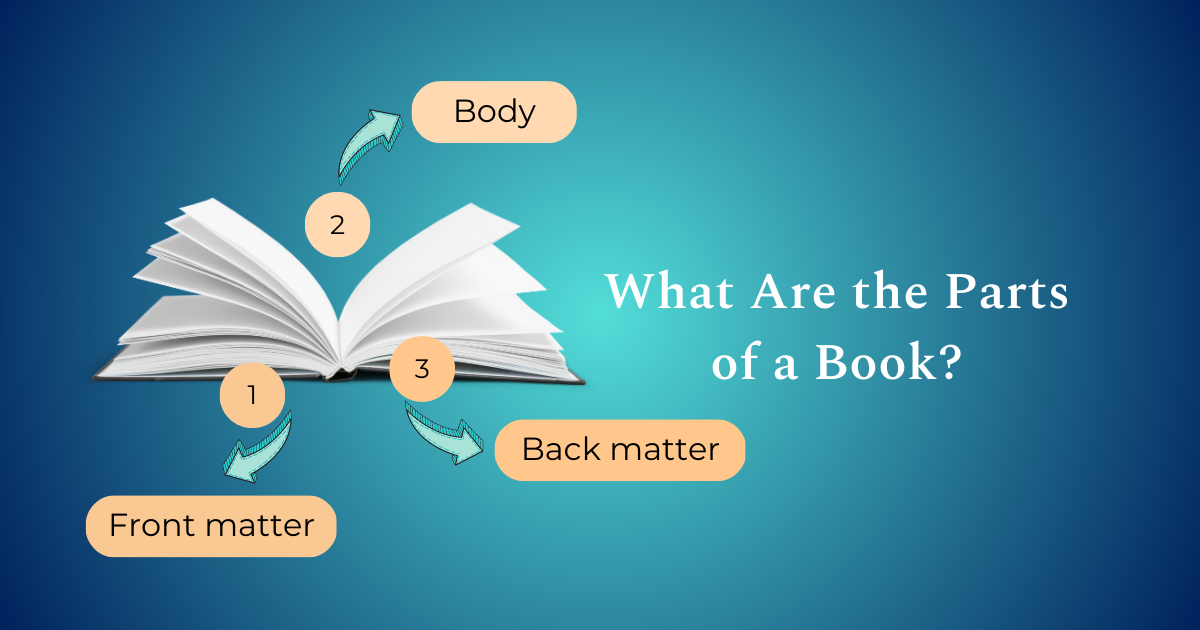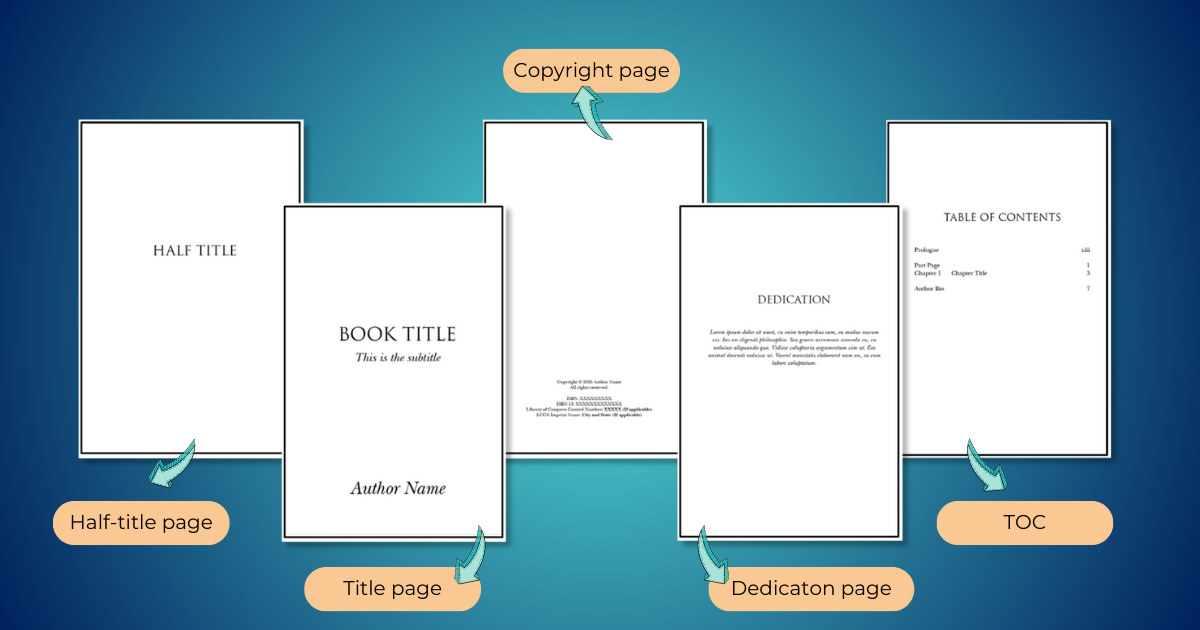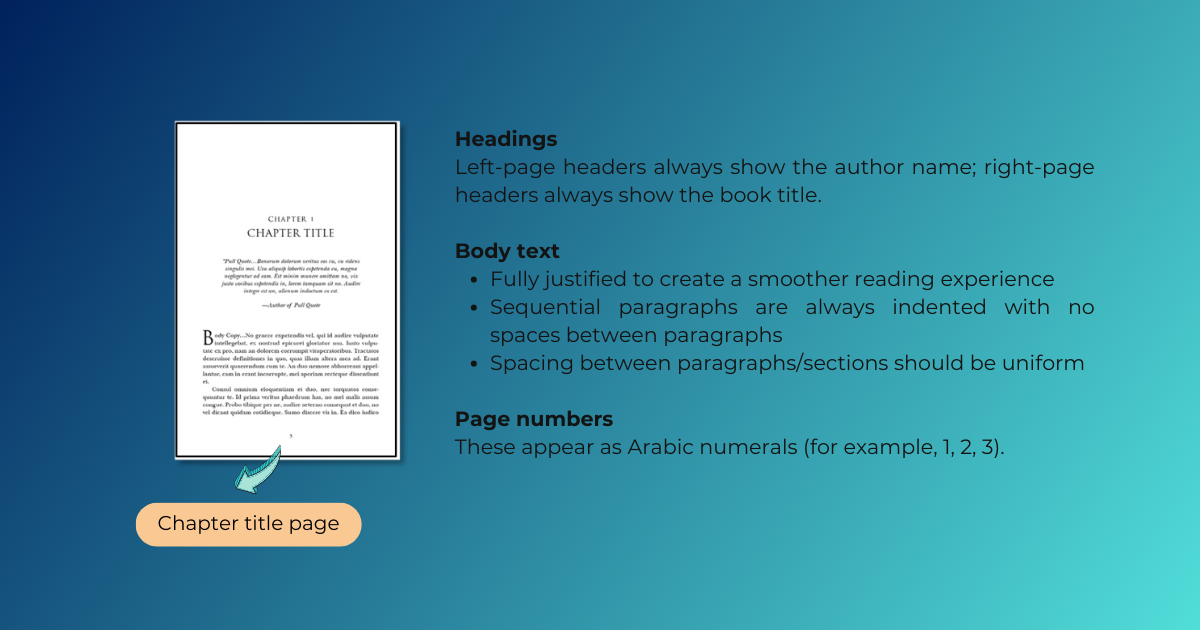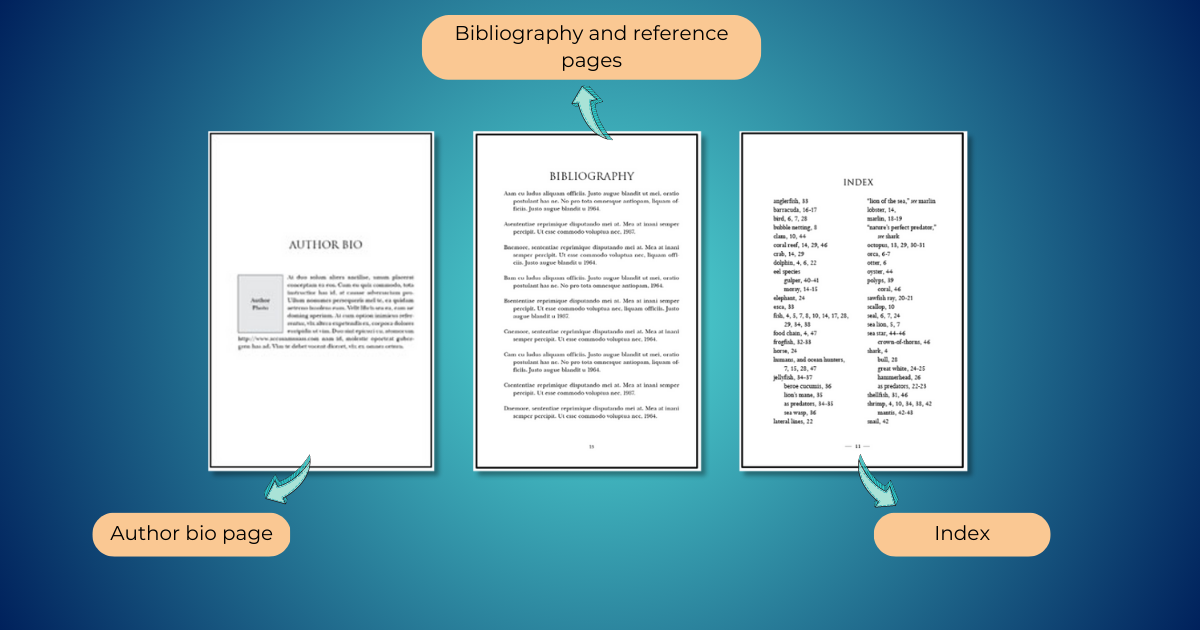Parts of a Book: Front Matter, Back Matter, and Body of a Book

For authors, books are not just content (also known as the body of the book). They are products authors create and market. Besides the body of a book, authors have to think of the beginning and end sections, which are called the front and back matter of a book.
In this article, we will go through the essential book parts authors should consider before publishing. The anatomy of the book is essential for authors who self-publish and can no longer rely on the experience of publishers, who have previously set the stage for what a well-considered book should be.
What Are Front Matter and Back Matter in a Book?
“Front matter” and “back matter” are terms used to describe the first and last pages of a book (but not the story or body content of the book). This includes pages like table of contents, copyright, bio, etc.
The purpose of the front matter is to make sure your book looks as professional as possible.
As a self-published author, you must be able to impress readers during their first look inside your book. This means it needs to look indistinguishable from a traditionally published book.
The front matter of a book plays a vital role in providing essential information and setting the tone for the content that follows. The front matter appears at the beginning of a book, while the back matter is found at the end. Together, the front and back matter act as informative bookends, framing the main body of the book and offering supplementary material.
Let’s talk about front matter vs. back matter and the body of the book in more detail.
What Is Front Matter in a Book?
As you delve into the parts of your book, you'll discover that the front matter includes a variety of sections, each serving a specific purpose.
Typically, the front matter comprises:
- the half-title page, which displays the title of the book and sometimes the author's name;
- the title page, which presents the full title, subtitle, author, and publisher;
- the left-hand page, which is the copyright page, featuring the copyright notice, publication details, and ISBN.
Additionally, the front matter body may contain a dedication page to a friend, family member or that special someone, acknowledgments, a table of contents, a foreword, a preface, and an introduction, depending on the book's genre and structure. These sections acknowledge contributors, provide context, and offer readers a glimpse of what to expect from the book.
The purpose of the front matter is to make sure your book looks as professional as possible. While it might not seem like a marketing tool, the book front matter does have an influence on sales.
The anatomy of the front matter body

Half-title page
- Placed on a right-hand, un-numbered page
- Mentions the title of the book
Title page
- Always comes after the half-title page
- Set on a right-hand, un-numbered page
- Includes the full title of the book and subtitles (if/ when the case)
- Consists of the name or pen name of the author
Frontispiece (optional)
- Authors may place an illustration or image on the left-hand page, opposite the title page.
Accolades (optional)
- Includes praise about the book from revered publications and esteemed authors, which are valuable on the book front to persuade readers to buy the book.
Copyright Page (colophon)
- Contains details about copyrights, the year the edition was released, the font used, the ISBN number, and information about the publisher and printer. It's typically found on the back of the title page.
Dedication page
- Has the name(s) of those to whom authors are dedicating the book.
- Books include the dedication page after the copyright page. It is usually placed on a right-hand page and numbered only if it extends beyond a page.
Table of contents
- Lists chapter titles and their corresponding page numbers. The table of contents (TOC) is a guide to all the major sections that appear after it, including the front matter and back matter and the content in the main body.
- May extend to several pages but always start on the right-hand page.
Epigraph (optional)
- Represents a quote or passage that reflects the book's theme. It may be sourced from various materials, such as other works of fiction, poetry, songs, or almost any other source.
- Appears right before the first chapter.
Preface
- Serves as an introduction penned by the author in which he offers insight into the book's creation or gives context to the present edition. To better answer the question ”What is a preface?” one can look at preface examples from various books.
Forward
- Is an introductory section composed by someone other than the author.
What Is the Body of The Book?
The book body also referred to as the book's main content or text block, encompasses the primary portion of a book that contains the actual narrative, information, or substance of the work. This section is situated between the front matter and the back matter.
The book body is typically organized into chapters or sections, with each focusing on specific topics, events, or ideas, depending on the book. In essence, the book body is the heart of the publication, providing readers with the core content and purpose of the work.
The anatomy of the body of the book

This is the most consistent section of the book. It has all the chapters and pages that comprise the book’s content. Authors should also pay attention to how this section is arranged, as it is essential to ensure readability.
Here are the parts of the book body [including some tips authors should know]:
Prologue (fiction)
- Is the text that comes before the main narrative in a book. If curious about what is a prologue of a book, authors should note it serves to set the scene and spark the reader's curiosity. An effective prologue serves various purposes within a narrative, including foreshadowing upcoming events, offering essential background information or backstory related to the central conflict, and setting the stage for the novel or play's overall tone.
- Encompasses captivating events that gain full clarity as the story progresses.
- Establishes a point of view, whether that belongs to the main character or another character who has unique insight into the story.
- Helps lay the foundation for the rest of the work, engaging readers and preparing them for the unfolding narrative.
Introduction (nonfiction)
- Is a several-page-long intro to the topic covered in the book. It presents events or details, ensuring the reader understands the topic before starting.
Note: The preface is personal to the author, where they explain the reasons for writing the book. In contrast, an introduction helps the reader understand the book's subject.
Chapters
- Divide the narrative using chapter headings or page breaks.
Tips for formatting chapters:
- Start on the right-hand side. Unlike regular pages with page headers, the chapter starter has none. As a general rule, left-page headers show the author’s name, while right-page headers show the book title.
- Focus on the capitalization and casing of the title, subtitle, and chapter numbers to adhere to the chosen design styles. The initial paragraph does not feature a first-line indent.
- Make sure the page numbers adhere to the chosen style and design; use Arabic numerals.
Epilogue (works of fiction)
- Represents a scene that wraps up the story, often set to occur sometime in the future.
- Unlike the prologue, the epilogue appears at the end of a book or play, offering resolution or closure, revealing the fates of characters, and reflecting on the story's themes or lessons.
- Provides a glimpse into the future or serves as a segue into a sequel, presenting a different point of view and offering commentary on the story, typically maintaining the same style as the main text.
If you wonder what an epilogue is, it can also serve as a teaser for upcoming books in a series by raising new questions or providing hints about future events.
Conclusion (nonfiction)
- Encapsulates the central notions and principles of the text.
Although conclusions formulated in decisive terms are becoming increasingly rare in nonfiction books, with many authors presenting their closing thoughts in the final chapter, academic theses might continue to follow this formatting style.
Afterword
- Is a final note written either by the author or by someone else familiar with their work.
Postscriptum
- Is a sentence-long comment that follows the narrative's ending and adds a few points to consider further. For example: ”Amelia Mary Earhart disappeared July 2nd, 1937, but her example continues to inspire women everywhere to date.”
What Is Back Matter in a Book?
Back matter constitutes the various elements at the end of a book, following its main content. The front matter introduces readers to the book and its context. Knowing what front matter and back matter are in a book ensures a book is organized and provides readers with a comprehensive reading experience.
The anatomy of a back matter body

Acknowledgments
- Set after the final chapter, the section rewards all those who have contributed to the creation of this book.
Author Bio
- Includes a brief summary of the author’s previous work, education, and personal life.
- Is always placed on the right-hand page.
Copyright permissions
- may appear both in the front matter and back matter. The back matter lists the sources of the extended fragments of books, lyrics, or other materials it had permission to include in the present work.
Appendix / Addendum (nonfiction)
- Includes supplementary information or recent updates relevant to the book, particularly concerning a more recent edition.
Chronology (nonfiction)
- Lists the events in a consecutive progression, which can be useful for readers, particularly when the narrative unfolds non-chronologically. Occasionally, this section may be included as part of the appendix.
Endnotes (nonfiction)
- Represent additional notes associated with specific text sections, indicated within the main body by superscript characters. These are predominantly used in nonfiction works.
Glossary
- comprises explanations of terms or other components found in the text. In fictional works, the glossary might include information about specific characters or locations.
- Organized in alphabetical order.
Index
- Compiles the specialized terms or expressions used within the book, accompanied by the pages where they can be located, enabling readers to find them. The index is generally arranged in alphabetical order.
- Is always placed on a right-hand page, and pages are numbered solely if the Index extends beyond one page.
Bibliography
- Represents a comprehensive formal list of citations. It is usually compiled following a manual of style.
- Is always placed on a right-hand page
Ready to Hit Publish?
With a book aggregator such as PublishDrive, authors find themselves within the perfect network of features and partners that enables them to access hard-to-get markets and increase their revenue.
Discover how to use metadata to increase discoverability, see how to advertise a book beyond the classical approaches, and turn new titles into instant bestsellers, but more so, see how to use the features of the PublishDrive platform to increase readership and royalties.